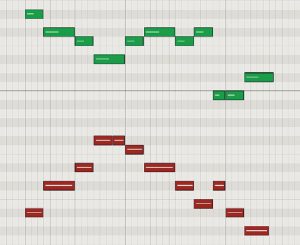X-Factory: Unknown Mortal Orchestra – Multi-Love
X-Factory: Unknown Mortal Orchestra – Multi-Love
This is the second time I’ve looked at an UMO song in as many years. Multi-Love‘s unconventional design stood out from the moment I heard it by being characteristically quirky on the surface, yet still allowing the listener to peel back the darker undertones on subsequent listens.
Ruban Nielson’s writing process has been discussed in many interviews and this song follows the lyrics last method, though as I understand it, the concept for the storyline was intrinsic to the development of the music itself.
Multi-Love kicks off with some truly Michael Nyman-esque keyboard delivery and although the true key centre is obscured until the eighth measure we eventually hear the tonic resolving as Eb minor. Keyboardists love using the black keys so that key signature makes sense from an instrumental standpoint.
Coincidentally this new song is in the same key (thereabouts) as the last UMO song I wrote about, Ffunny Ffriends. That was in F# major (the relative major of Eb minor) and being a guitar-driven song stood out as not being the first key of choice for most as it doesnt allow for any open string chords to be utilised. The choice of key, I assumed would have been down to the vocal span that Ruban uses, obviously F# major nails the sweet spot in his range!
Interestingly like Ffunny Ffriends, Multi-Love also starts on chord IV, which assists in concealing the home key by setting up a false tonic, the opening chord Ab minor. We only get closure on the key centre after the wonderfully classical Bb sus 4-3 pushing us to Eb minor. In olden days it used to be common practice to modify the V chord in minor keys to become major and thus create a more satisfying dominant to tonic cadence involving a raised leading note (in this case, D natural). *
Structurally we are also thwarted in defining a conventional groove by Nielson’s opening six beat harmonic rhythm, which when coupled by a very UMO trait of stressing unimportant sylLABles, sets up a degree of tension, eerily reinforced by the developing storyline, fragmented though it is. This tension drives the listener forward in each stanza until they are released by the aforementioned Bb sus 4-3 – Eb minor cadence into a more obvious 4/4 common time groove.
There are only two different sections to this song, with structural variance leaning on sonic texture rather than a bridge. Each verse (see chart) contains the eponymous opening refrain “Multi-love” and closes with “She wants to be your love” and occurs twice each time before the more commonly phrased eight measure 4/4 chorus shifts the focus away from complexity and dissipates the tension.
Even though the chorus is more straightforward it also snags you aurally by tagging on what feels like an extra Ebm to Db oscillation at the tail of the phrase, these extra chords should help define the square feeling of the eight measure section, but their repetition so close to one another can trip you up!
One fascinating and subtle device at play, (if subconsciously divined all very well – but if intentional, pure genius) is a lovely inversion of the melodic contour spanning the phrase from measure five where the 4/4 time consolidates to the Bb sus chord (green notes). The inverted sequence (red notes) occurs at the same structural point in the second half and because each verse utilises the same harmonic progression it manages to set up a clear melodic distinction between the two halves, in an understated sort of way.
In the attached piano roll I have placed the second half of the verse an octave below sounding pitch to get a better perspective on how the melodic contour mirrors itself.
Multi-Love is another extremely engaging construction from UMOs creator with multiple layers of tension pushing and pulling the listener through a veritable Willy Wonka factory of sonic sweetness. That the underlying saga of a doomed ménage à trois has been so candidly (and artfully) woven into what is ostensibly a funky 3:30 pop tune belies the songs true nature as a bittersweet and deeply cautionary modern fable, rendered beautifully in song.
* In major keys the 1st, 4th and 5th degree of the scale (when stacked from the root in diatonic thirds) create major chords, all the rest are minor and the 7th is a doubly dark diminished chord. In the relative minor this changes dramatically with the 3rd, 6th and 7th chords becoming major due to the shift of a minor third down.
Godfrey de Grut is a Silver Scroll co-winner with Che Fu, MD of the 2013 Silver Scrolls and was co-artistic director of Christmas in the Park 2015. He is a freelance writer, arranger and producer, lecturing in popular music studies at the University of Auckland. Follow his musical ramblings @GodfreyDeGrut on Twitter or email godfrey.degrut@gmail.com

